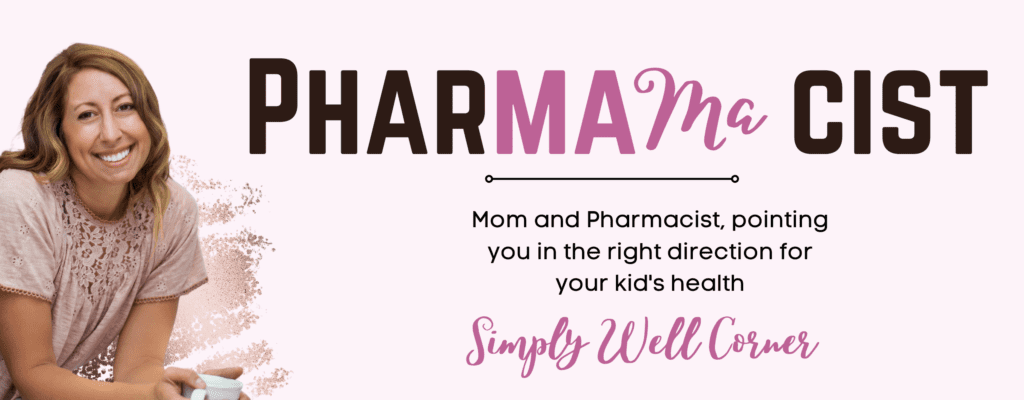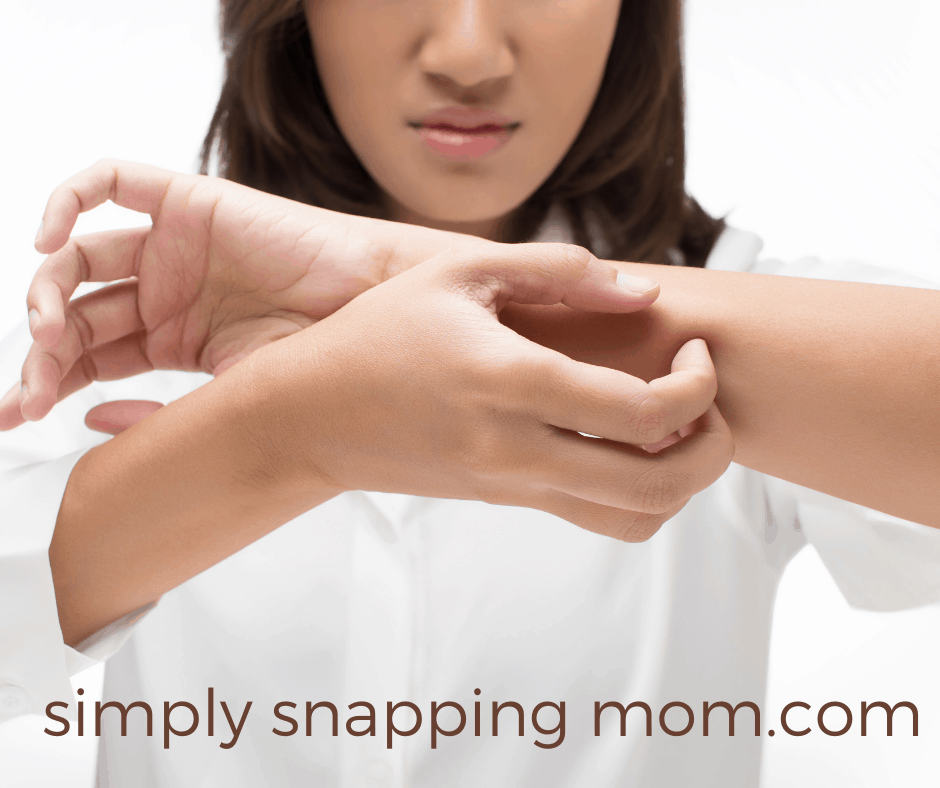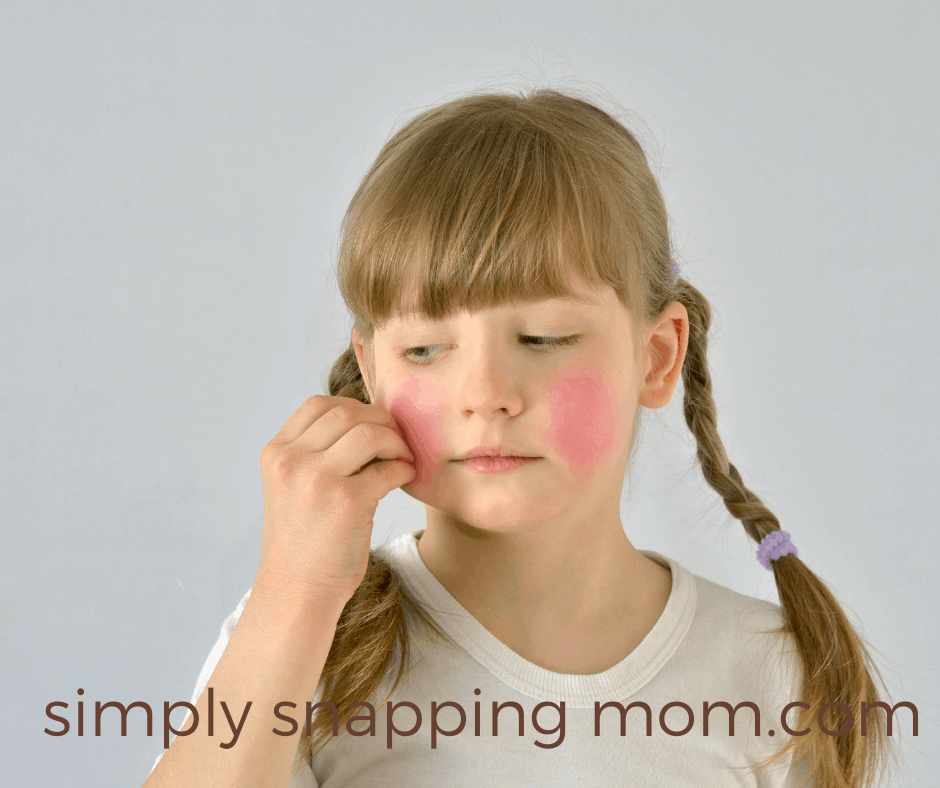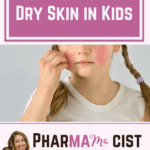As part of the Simply Well Series, we review the most frequently asked questions I receive in the pharmacy. In this edition, I answer “How do you treat dry skin in kids?”
Your friendly pharmacist mom here to talk about something we have no doubt all experienced. Skin that becomes itchy, rough, and scaly- Yup, you guessed it, dry skin. Dry skin may seem like a simple topic, but when you (or your children) experience the relentless itching, it does not seem so benign.
Dry skin, also known as xerosis, is the most common cause of itching. It affects about 50% of adults, and many children, also. It is most common when there is low humidity (like in winter). Dry skin can be pesky to treat; however, when you know lifestyle changes you can make, products you can use, and when to call the doctor, you can effectively manage it.
First and foremost, this post is not to override anything your healthcare provider or pharmacist told you. Secondly, stop reading and call your doctor if:
- Your child with dry skin is under 2 years old
- There is a possible infection – the skin is hot to the touch, the skin is excessively red or bleeding, it is oozing or contains pus
- The rash covers a large part of the body
- The itching is severe and keeping you, or your child, up at night
Let’s take a look at what we can do to restore hydration to your skin and combat this annoying condition.
Lifestyle Changes
There are some very easy methods to hydrating your skin. These three lifestyle changes may seem simple, but they are a great first step to take, especially if you are treating dry skin in children.
First, make sure you or your child is hydrated. Drinking plenty of fluids will start to hydrate your entire body, including the skin. It may seem self-explanatory, but it will make a big difference.
Secondly, purchase and set up a humidifier. Humidifiers will add moisture to the air and start to battle one of the primary causes of dry skin – low humidity. I recommend a cool mist humidifier over a warm mist humidifier. Warm mist humidifiers can get very hot, and are therefore dangerous around children. We have the below cool mist humidifier set up in each of my three kids room’s and it does a great job efficiently hydrating the air. It is a quiet humidifier and has automatic shut-off options.

Lastly, modify your bath routine. Taking frequent, long, hot baths or showers will no doubt dry out the skin. If your child has dry skin, do not allow them to stay in the bath for longer than 15 minutes. Make sure the water is not too hot, and if possible extend baths to every other day, or as needed. It is best to pat your skin dry after bathing and apply the moisturizers at that time to hold in water.
Products to treat Dry Skin in Kids
If you walk into your local pharmacy to pick out a product, you will be instantly overwhelmed when you walk through the 30 foot long row of creams, ointments, and moisturizers. Understanding what the different products are and when to use them will help you select the appropriate option.
As a general rule of thumb:
- If the skin is slightly dry, you can stick with creams or lotions
- If the skin is very dry, get an ointment (thicker than cream)
Also, I fully support generic products! They are equally effective and much cheaper.
Related: How Much Benadryl can Your Child Take?
Oatmeal Baths
Oatmeal baths can help sooth irritated skin. You add the oatmeal product directly to the bath, and relieve itching instantly. Aveeno makes a great product that we use frequently for dry skin, and I recommend to patients with dry skin first.

Gentle Cleansers
Harsh soaps can cause or worsen dry skin. Even some products that claim they are ‘gentle’ may actually contain ingredients or perfumes that can irritate dry skin. The best soap for dry, irritated skin is Cetaphil. I highly recommend this for anyone who suffers dry skin. It can be used on the body and the face

Moisturizers
Moisturizers can be applied anytime to combat dry skin. These products work by holding water in the outermost layer of skin, they also act as a temporary barrier for your skin.
Some of these products also come as bath oils. I typically don’t recommend bath oils because they quickly evaporate and are not incredibly effective.
My favorite moisturizer is Aquaphor. It comes as an ointment; therefore, it is best for more severe cases of dry skin. For my children, I feel that it almost cures their dry skin overnight. It is thick so I slab it on before they go to bed.

Humectant
Humectants are oily products that attract moisture to the skin. They can be used anytime, but the oiliness can be annoying, so I typically recommend these only at night. An example of an humectant is Neutrogena Norwegian formula.
Ceramides
Now for my all-time favorite skin care product {Drum roll please…} CeraVe! CeraVe is a Ceramide. Ceramides help form the skin’s barrier, which helps the skin retain moisture. Recently, my son had such severe dry skin on his face after a cold that his cheeks looked raw. After using the below ceramide product (CeraVe) for two days, his skin was fully back to normal!

For Severe Dry Skin
Urea and Lactic Acid Products
If you are treating severe dry skin, you may have to step it up a notch and get either a urea containing product or a lactic acid product.
Urea products work by actually penetrating through dry skin, which is rough, stiff and difficult to penetrate. As this is a strong product, reserve this for more severe cases. Urea creams typically contain anywhere from 5-50% urea. The higher the percentage, the more urea, and the best for tougher skin such as on the feet. For dry skin, I recommend a lower percent, like the 10% product below.

Lactic acid products are also very effective for more severe cases of dry skin. These products help to exfoliate the skin, allowing for more moisture to break through. I recommend the following products, Amlactin and Lac-hydrin. If your pharmacy doesn’t carry on the shelves, often the pharmacist can order it for you.

If your child has a rash or extreme itchiness, it could be a sign of a condition called atopic dermatitis, or eczema. While the American Academy of Pediatrics (AAP), offers some great ways to treat eczema, it is important that you consult with your child’s pediatrician if you suspect they have this condition. Since eczema looks different for kids of different ages, the National Eczema Foundation details out exactly what you should look for.
When to Call the Doctor
As stated in the beginning, before treating on your own, call your healthcare provider if any of these apply to you:
- Your child with dry skin is under 2 years old
- There is a possible infection – the skin is hot to the touch, the skin is excessively red or bleeding, it is oozing or contains pus
- The rash covers a large part of the body
- The itching is severe and keeping you, or your child, up at night
If severe, the doctor may want to rule out other causes, such as dermatitis (infection), fungal infections, psoriasis, and eczema.
Additionally, if you are treating dry skin in a child, check in with your doctor before trying the stronger products- which contain urea or lactic acid.
If after 7 days of treatment the symptoms have not improved OR have worsened, call your doctor!
You may also find helpful: How to treat Constipation with Miralax in Kids
Final Thoughts
Treating dry skin is not brain surgery, but without the correct knowledge you will be stumbling through the pharmacy like an itchy zombie just staring at a wall of products.
In adults and children, it is best to take the step-wise approach- lifestyle changes first, then gentle products next, and moving on if needed! In no time, you will tame that pesky itch!
If you found this helpful, share it!





Sheena Moncatar
Wednesday 12th of December 2018
Staying hydrated is really essential not just for kids but even for adults. One would be doing their skin a great favor. Thanks for sharing this great post.
Gabriela Feješová
Tuesday 11th of December 2018
As the winter arrived, I'm sure lots of people will benefit from this blog post. I didn't know about some products mentioned above, but I'm going to give them a try. Thank you for sharing. :)
Romualdo II Atibula
Tuesday 11th of December 2018
This is very helpful to those who have dry skin. Thank you for sharing this information.
Danielle
Monday 10th of December 2018
Dryness has been a huge problem these recent weeks with the weather changes. Thank you for sharing.
Narmeen
Sunday 9th of December 2018
Aveeno is my favourite!